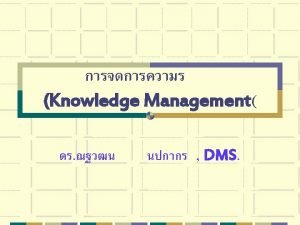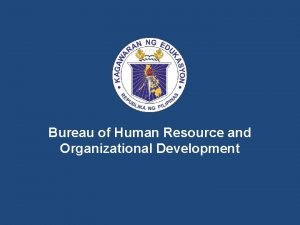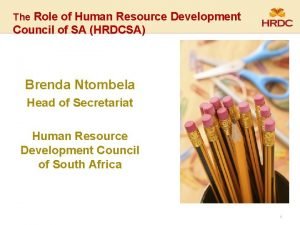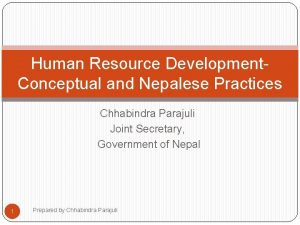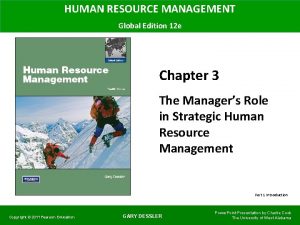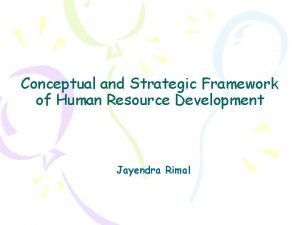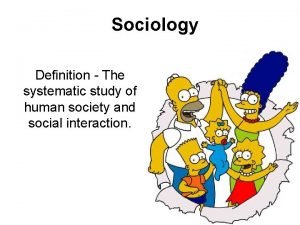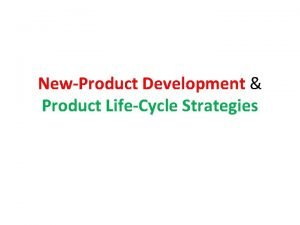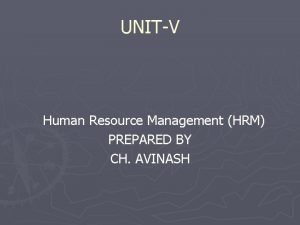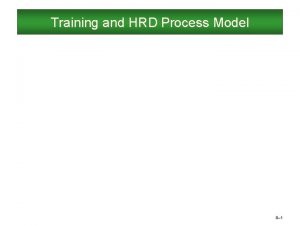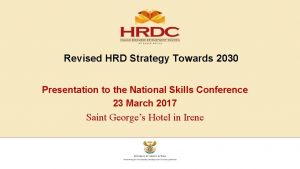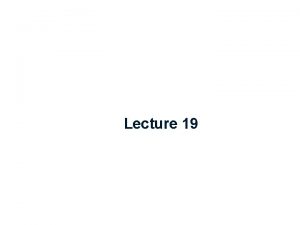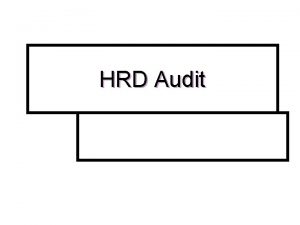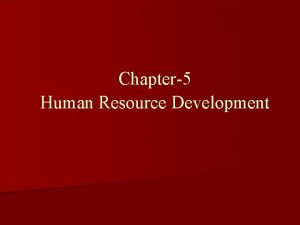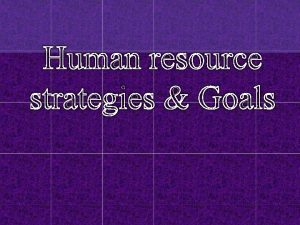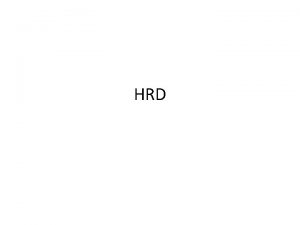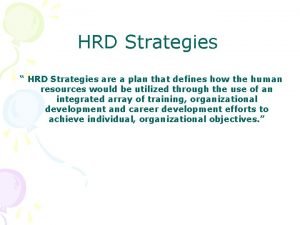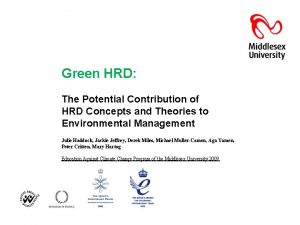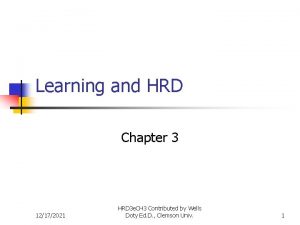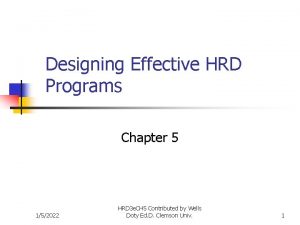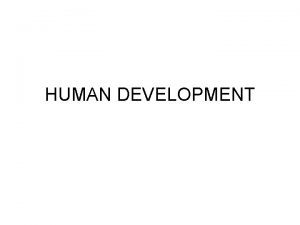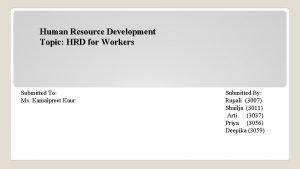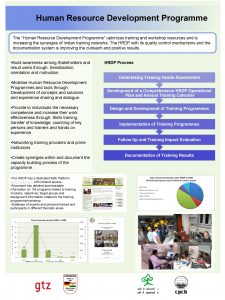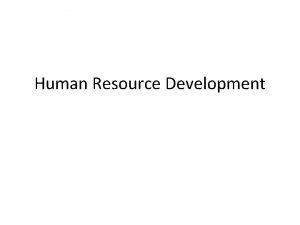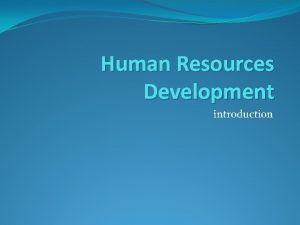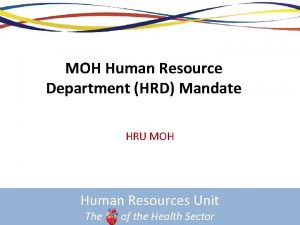Human Resource Development HRD A set of systematic





















- Slides: 21

Human Resource Development • HRD: A set of systematic & planned activities designed by an organization to provide its members with necessary skills to meet the current & future job demands. • HRD is a process by which employees of an organization are helped in a continuous & planned way to: • Acquire & Sharpen their competencies(knowledge, attitude , values & skills) required to perform current or expected future roles. • Discover & exploit their inner potential. • Bring about an integration of individual & organizational goal. • Develop an organizational culture of trust, openness, team work & collaboration. 4/8/2011 VINAY SHARMA, FACULTY IN MBA, BHADERWAH CAMPUS , UNIVERSITY OF JAMMU

Human Resource Development • The concept of HRD: 1. HRD treats the persons working in an organization as the most valued assets & recognize the need to invest time & efforts to develop them. 2. Human beings should not be treated as natural resources as they have their own needs , values & other characterstics. 3. HRD performs three functions: 4/8/2011 1. Training & Development I. Training: improving knowledge, skills & attitude forshort term or specific job or tasks. II. Development: preparing for future responsibilities, while increasing the capacity to perform at a current job. 2. Organizational Development(Change at micro and macro levels) 3. Career Development. VINAY SHARMA, FACULTY IN MBA, BHADERWAH CAMPUS , UNIVERSITY OF JAMMU

Need for HRD • New HRD departments or strengthening of existing HRD function is necessary due to the following reasons: 1. To support the structural & Strategic changes made by organization to promote its growth & expansion. 2. Recognition of importance of HRD & its implementation by the top management. 3. To prepare employees to respond to increasing problems faced by the organization both internally & externally. 4. HRD is needed to bring about system-wide changes 5. HRD is needed to develop a proper climate in the organisation 6. A mechanism for continuous organisational and individual renewal. 4/8/2011 VINAY SHARMA, FACULTY IN MBA, BHADERWAH CAMPUS , UNIVERSITY OF JAMMU

Need for HRD 7. Implementing a new policy 8. Implementing a strategy 9. Effecting organisational change 10. Changing an organisation’s culture 11. Meeting changes in the external environment 12. Solving particular problems 13. Technological change creates requirements for training and development 4/8/2011 VINAY SHARMA, FACULTY IN MBA, BHADERWAH CAMPUS , UNIVERSITY OF JAMMU

GOALS OF HRD 1. To enable the capability of each employee as an individiual in relation to his present & future role. 2. To develop the dyadic relationship between each employee & his/her superior. 3. Integration of people development with the organizational development. 4. To develop team spirit in people working in an organization. 5. To develop the human resources philosophy for the entire organisation & get the top management committed to it openly. 6. To develop cooperation & Collaboration among different units of the organisation. 7. Maximization of learning opportunities of individuals in an organisation 4/8/2011 VINAY SHARMA, FACULTY IN MBA, BHADERWAH CAMPUS , UNIVERSITY OF JAMMU

GOALS OF HRD 8. 9. 10. 11. 12. 13. 14. 15. To maintain the overall health of an organisation. Balancing of change & adaption. HRD is needed to develop competencies. Create environment for the trainees conducive to their character building. Promote a culture of creativity, innovation, human development, respect and dignity. Provide opportunity for development of different level of employees need based training programs Prepare newly inducted staff to perform their work with high level of competency and excellence. 4/8/2011 VINAY SHARMA, FACULTY IN MBA, BHADERWAH CAMPUS , UNIVERSITY OF JAMMU

Challenges for HRD • • • Changing workforce demographics. Competing in global economy. Eliminating the skills gap. Need for lifelong learning. Need for organizational learning. 4/8/2011 VINAY SHARMA, FACULTY IN MBA, BHADERWAH CAMPUS , UNIVERSITY OF JAMMU

HRD Process Model • HRD process should use the following four phases: 1. 2. 3. 4. Need Assessment Design Implementation & Evaluation 4/8/2011 VINAY SHARMA, FACULTY IN MBA, BHADERWAH CAMPUS , UNIVERSITY OF JAMMU

HRD Process Model 4/8/2011 VINAY SHARMA, FACULTY IN MBA, BHADERWAH CAMPUS , UNIVERSITY OF JAMMU

HRD Subsystem & Interventions • • HRD subsystems or HRD interventions/instruments are the tools , which are used to spread the HRD efforts in an organisation. Some of the mechanisms are as: 1. Role Analysis 2. Performance appraisal 3. Potential assessment 4. Career planning 5. Review discussions 6. Training & Development 7. Communication 8. Job Enrichment 9. Job Enlargement 10. Reward 11. OD VINAY SHARMA, FACULTY IN MBA, 4/8/2011 BHADERWAH CAMPUS , UNIVERSITY OF 12. Quality of Work life JAMMU

HRD Subsystem & Interventions 12. 13. 14. 15. 16. Grievance Mechanism Human Relations approach Workers Participation etc. Human Resource Information System. Feedback, counseling & coaching. Various HRD methods when properly designed & implemented, generate a number of HRD processes which in turn make people more competent and the organization more effective. For example: ü Role analysis indicates the key functions associated with each role & key competencies required to perform the job. ü Job rotation develops the general management skills and empathy & understanding towards other job roles. 4/8/2011 VINAY SHARMA, FACULTY IN MBA, BHADERWAH CAMPUS , UNIVERSITY OF JAMMU

Career Planning • It is the process by which one selects career goals & paths to achieve these goals. The major focus of career planning is on assisting employees achieving a better match between personal goals & opportunities that are available in organization. It is done through following ways: • Career Counseling • Career development workshops 4/8/2011 VINAY SHARMA, FACULTY IN MBA, BHADERWAH CAMPUS , UNIVERSITY OF JAMMU

OD • OD is deliberately planned, organization –wide effort to increase an organization's effectiveness. It is process for applying behavioral science principles & practices in organizations to increase individual & organizational effectiveness. 4/8/2011 VINAY SHARMA, FACULTY IN MBA, BHADERWAH CAMPUS , UNIVERSITY OF JAMMU

Objectives of OD • • TO increase level of Inter- personal trust among employees. TO increase employee’s level of satisfaction & commitment. To confront problems instead of neglecting them. To effectively manage conflict. To increase cooperation among employees. To increase organization problem solving. TO help improve ongoing operations on continuous basis.

Employee welfare & Quality of work life • • It includes following: Employees involvement Quality circles Suggestion programs Self managed work teams Co-determination Open door policies 4/8/2011 VINAY SHARMA, FACULTY IN MBA, BHADERWAH CAMPUS , UNIVERSITY OF JAMMU

Human resource information system • • Improve paperless HRM Capabilities Better communication Automation of HRM operation processes Consolidated HRM information 4/8/2011 VINAY SHARMA, FACULTY IN MBA, BHADERWAH CAMPUS , UNIVERSITY OF JAMMU

HRD outcomes Following are the various outcomes of HRD: 1. Training makes people more competent. (skills , knowledge & attitude) 2. Greater clarity of norms & standards. 3. More Commitment towards the job. 4. Great trust & respect for each other. 5. Greater collaboration & team spirit which results into synergy effect. 6. Problem solving capabilities: People get equipped with problemsolving capabilities. 7. Lot of Useful & objective data on employees are generated which facilitate human resource planning. 8. Participation develops in workers a sense of achievement, belongingness & pride for VINAYwork. SHARMA, FACULTY IN MBA, 4/8/2011 BHADERWAH CAMPUS , UNIVERSITY OF JAMMU

Organizational Effectiveness The best quality of the services and products provided by organization so as to achieve maximum productivity and satisfaction in terms of organizational, social and individual goals.

Organizational effectiveness in form of • • Reduced Wastage. Higher Cost. Motivated and Disciplined work Force. Better Image.

Objectives of OD • • TO increase level of Inter- personal trust among employees. TO increase employee’s level of satisfaction & commitment. To confront problems instead of neglecting them. To effectively manage conflict. To increase cooperation among employees. To increase organization problem solving. TO help improve ongoing operations on continuous basis.

4/8/2011 VINAY SHARMA, FACULTY IN MBA, BHADERWAH CAMPUS , UNIVERSITY OF JAMMU
 Total set awareness set consideration set
Total set awareness set consideration set Training set validation set test set
Training set validation set test set Human resource development framework
Human resource development framework Hrm past questions and answers
Hrm past questions and answers Bhrod
Bhrod Conclusion for training and development ppt
Conclusion for training and development ppt Importance of human resource development in nepal
Importance of human resource development in nepal Hr strategy map
Hr strategy map Kasocs
Kasocs Human needs and human development chapter 8
Human needs and human development chapter 8 Chapter 8 human needs and human development
Chapter 8 human needs and human development Human development index definition ap human geography
Human development index definition ap human geography Resource loading vs resource leveling
Resource loading vs resource leveling Perbedaan resource loading dan resource leveling
Perbedaan resource loading dan resource leveling Systematic definition sociology
Systematic definition sociology What is strategic management
What is strategic management Project appraisal
Project appraisal Prioritizing hrd needs
Prioritizing hrd needs E hrdsa
E hrdsa Assessing need for hrd
Assessing need for hrd Implementation of hrd program
Implementation of hrd program Literal sense in hrm
Literal sense in hrm


